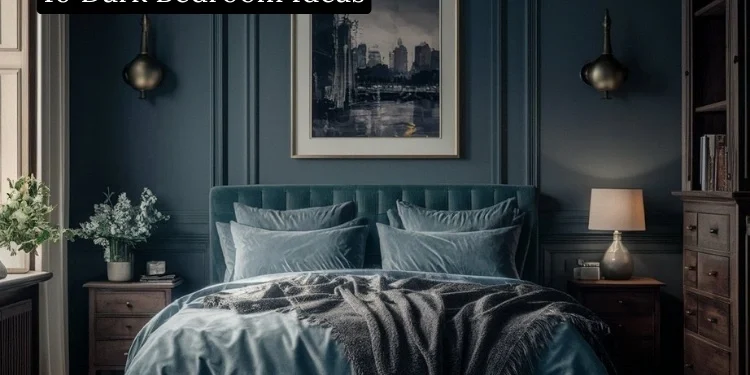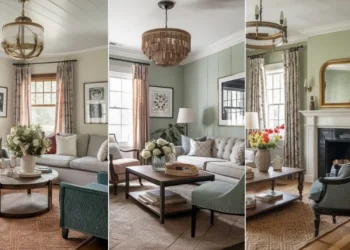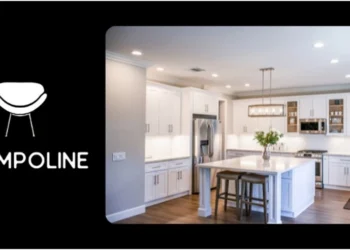We’ve all experienced those nights where we toss and turn for hours, struggling to fall asleep. Insomnia can seriously impact our quality of life, whether it’s a busy mind, an uncomfortable bed, or general restlessness.
However, achieving a good night’s sleep can be challenging. The secret to slumber may be as simple as redecorating your bedroom. Say goodbye to dull, all-white spaces and hello to moody, dark bedroom ideas that will have you drifting off in no time.
Benefits of a Dark Bedroom
Dark colors have been getting increasingly popular in bedrooms lately, for good reason. Deeper hues have a way of blurring the lines of a room, making even smaller spaces feel more extensive and more enveloping. They also mimic the atmosphere of night, which cues our bodies that it’s time to relax.
“By sleeping in a room that complements our natural sleep cycles, we’re more likely to repair our circadian rhythms, stimulate melatonin production, and get a deeper, more restful night’s sleep,” says Brooklyn-based interior designer Danielle Fennoy.
How to Design a Dark Bedroom
Designing with dark colors takes some careful planning. The key is keeping saturation consistent throughout the space. This ensures everything blends cohesively. Color block your “fixed” elements, like walls in similar shades, before layering them in “flexible” fixtures. It is also essential to maintain balance.
Pair dark walls with lighter furnishings for visual relief. Factor in warmth with materials like wood and fabrics. Finally, consider lighting options that are not too harsh at night and allow the room to transform fully come sunset. With the proper techniques, your dark bedroom will feel calming and welcoming.
Best Dark Bedroom Ideas
If your bedroom doesn’t have that perfect nighttime feel, try adding darkness with these inspiring dark bedroom ideas. Discover the restful benefits of a dark room and check out these transformations for better sleep.
1. Go Bold with Dark Walls
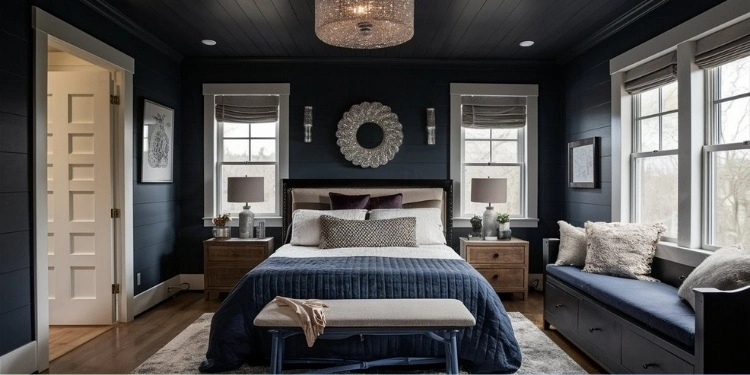
Some people enjoy going all in with dark paint in the bedroom. This can be very cozy and set a relaxing mood. In one bedroom example, the property owner used dark blue paint not just on the walls but also on the ceiling. This helps make the space feel more enclosed and nighttime-like. They added light features, too, like a sparkly chandelier.
This keeps the room from feeling too dark and gloomy. Going fully dark with your paint color works well in smaller rooms since it can make them seem more significant. It’s also lovely for bedrooms that don’t get much natural light from windows.
2. Take Dark Hues onto Furniture
Rather than just focusing on the walls, continue dark tones onto durable furnishings. One bedroom displayed incorporated navy walls along with wooden furniture stained a coordinating dark shade. This creates a cohesive look where all the elements harmonize together seamlessly.
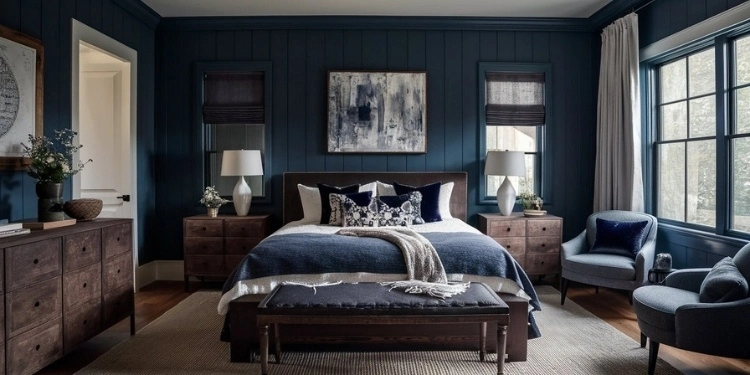
Bringing color into long-lasting furniture makes the space feel more put together and polished than darkened walls. The matched palette provides soothing uniformity that is ideal for relaxation.
3. Inject Pops of Color
Deeper tones create a peaceful backdrop, but you’ll also want visual flair. Boldly contrast darker foundations with lively pops, like a room with inky walls plus bright bedding. Keeping hue saturation similar maintains equilibrium without high contrast that could be jarring.
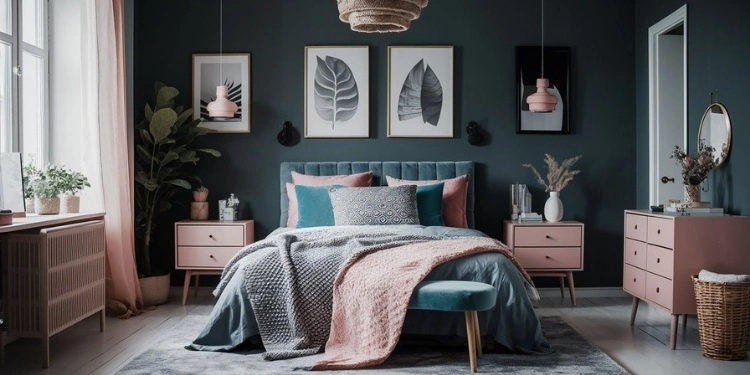
Pastel accents, like a blush nightstand, provide charming flair amongst deeper solids. Pops of patterns, such as throw pillows, infuse soothing layers. The balanced combination keeps the mood relaxed while preventing monotony.
4. Opt for Contrasting Floors
Wood floors may lighten up dark colors too much, so look to alternative flooring that complements. One bedroom demonstrated this harmony through teal walls and lighter gray floorboards below.
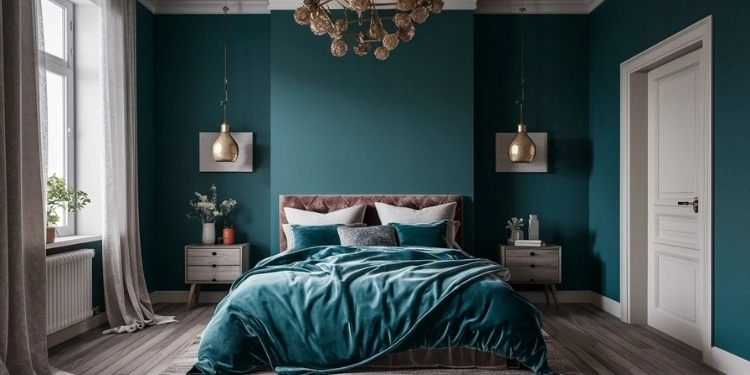
This combination allows the rich paint hue to stand out beautifully without competing with the flooring. The light-colored substrate provides visual relief to the bold color above, creating a visually pleasing aesthetic.
5. Indulge in Wall Coverings
While paint is a popular choice, wallpaper adds elevated drama. Luxurious gold grasscloth, like that used in one room, spreads beauty by reflecting the warm glow of lamps. Or lush printed papers make an artistic statement beyond bare, solid walls.
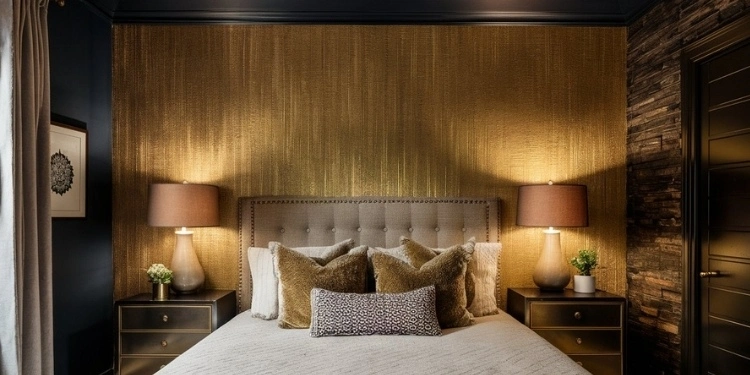
Textured options help bounce flattering ambient lighting around the space for a transformative, refreshed atmosphere. The lavish impact adds that final polished touch ideal for rest.
6. Softly Layer Darkness
All-dark everything could feel too intense, like being in a cave, so vary shades subtly. Try navy primary walls merging into secondary sides painted lighter or in a medium tone.
Maintain airiness with lightened bedding, like one bedroom exemplified by its balanced approach. Nicely contrasting darks create visual intrigue without harshness, so you can peacefully drift to dreamland. Tasteful variation spreads coziness.
7. Embrace Dark Woods
Remember about organic materials that lend natural ease to dark interiors. One bedroom incorporated warm paneling, and beams stained a deep brown shade. Paired with other wooden furniture elements, it grounded the rich hues.
The balance of earthy dark wood and painted darks makes for a comforting fusion of modern and rustic aesthetics. Each different material adds textural layers that relax both the mind and body.
8. Have Fun with Pops of Color
Sticking strictly to monochrome hues could become dull over time. Brighten it with a cheerful dash, like one room containing a minty nightstand amongst an otherwise moody backdrop.
This uplifting pop of color provides visual interest without overpowering the foundation – keeping the space soothing yet playful and unique to your style. Even dramatic interiors need a splash of whimsy to feel lively instead of severe.
9. Finish with Soft Textiles
Wrap it all together after choosing your dark background and finishing with cozy fabrics, ideally like a warm hug. Pile on the layers with plush blankets, plush pillows, and shag rugs to make surfaces feel cushy.
As furniture is touched throughout the day and night, these textural surfaces transmit comforting feelings of ease and relaxation from head to toe. Their lushness competes with none of the color elements already established for perfect harmony in your bedroom sanctuary.
In Summary
The key to any dark bedroom is balance. Keep furnishings light or white for counterpoints to mute backgrounds and use lamps instead of harsh overhead lights at night. Layer warm materials, bring natural elements where possible, and finish with dreamy bedding.
With these tricks, your dark bedroom will be anything but dull – it will wrap you in restorative repose and keep you well-rested each day. Bid insomnia goodnight and say hello to a genuinely relaxing shut-eye. Your slumber sanctuary awaits!

